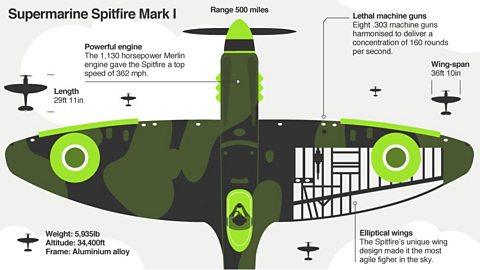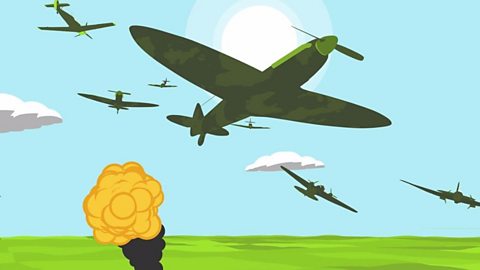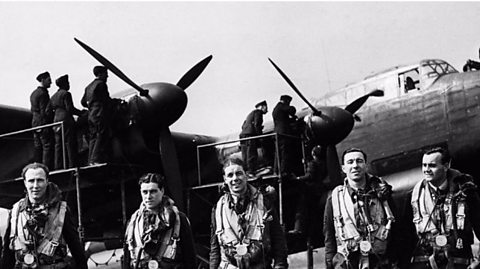A symbol of victory
The Spitfire is the most famous plane of World War Two. Its groundbreaking design and superior specifications gave the British a decisive advantage fighting the Luftwaffe in the Battle of Britain.
But early models were often cruelly exposed in head-to-head duels with the enemy. It was only after multiple improvements that the Spitfireβs winning combination of speed, manoeuvrability and firepower turned it into a formidable killing machine and a much loved British icon.
A design classic
The Supermarine Spitfire Mark I was an elegant and agile fighting machine. The groundbreaking original design meant the plane could be upgraded with new engines and armaments.

Fighting a world war
The Spitfire played its part in many of the crucial battles of World War Two, giving the RAF a critical edge over the German Luftwaffe.
The ground breaking original design meant the plane could be upgraded with new engines and armaments. As the war progressed so did the Spitfire. After the original designer RJ Mitchell died in 1937, his successor Joe Smith developed the fighter to make it faster and more powerful.
Battle of Britain
In 1940 Hitler sent 2,600 Luftwaffe fighters and bombers to destroy the Royal Air Force. At the start of the battle the RAF only had 640 fighters β Hurricanes and Spitfires β and German commander Herman Goering confidently predicted victory would only take a few days.
Britain stepped up the production of fighter planes, building them faster than Germany. The Hurricanes, with their sturdy frames, took on the bombers. The Mark I Spitfires, with their superior speed and agility, were sent up to shoot down German fighters. By the end of the battle the better organised RAF had defeated the Luftwaffe and downed 1,887 German planes. The RAF lost 1,023 planes.
The tide of the war started to turn. Britain was now a launch pad for future attacks on Germany.
Air battle for Malta
Malta was a key strategic Allied base in World War Two. Axis forces laid siege to the island and attacked British supply ships. By 1942 stocks were running low. The RAF called for reinforcements and over the summer hundreds of Spitfires were shipped in by aircraft carriers.
These improved Spitfire Mark Vs had a top speed of 371mph and were armed with powerful 20mm cannons. The plane proved decisive in gaining air superiority. The siege was broken and Malta became an important base for supplying British troops in Africa and launching future attacks on Italy.
D-Day
In June 1944 Spitfires played an important part in the biggest seaborne invasion in history as the Allies landed in Normandy and gained a crucial foothold in France.
The latest Spitfire Mark IX had a 1,720 horsepower engine and was equipped with both 20mm cannons and .50 calibre machine-guns. The fighters provided crucial air support for the D-Day landings and many were adapted to be fighter-bombers to carry out attacks on German ground forces.
Learn more about this topic:
WW2: What was the secret to winning the Battle of Britain? document
The Battle of Britain was a pivotal moment in World War Two, when the country stood alone against Hitler's seemingly unstoppable military power. This guide explores this historic period through text and infographics.

WW2: Could you be part of a Lancaster Bomber crew? document
A Lancaster bomber was one of the most dangerous places to be in WW2. Find out if you would have what it takes to be part of the crew.

WW2: How did the British plan to celebrate VE Day? document
VE Day or Victory in Europe Day was on 8 May 1945, following Germany's surrender in WW2. But how did Britain plan for one of the greatest days in its history?
